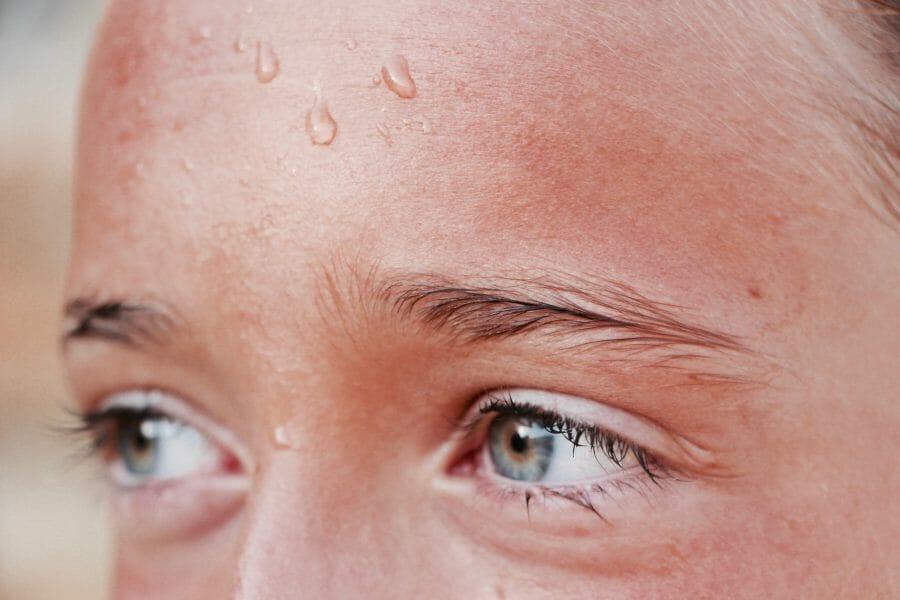What is "hyperhidrosis"? Hyperhidrosis is characterized by increased sweat secretion, with the number and size of sweat glands in affected individuals remaining unchanged. The disease is therefore a functional disorder.
There are 2 forms:
-
-
- Primary (idiopathic) hyperhidrosis: increased sweating without underlying disease. About 1 to 2.9% of the population is said to be affected by primary hyperhidrosis.
- Secondary hyperhidrosis: increased sweating due to an underlying disease. This includes infectious diseases, cancer, neurological disorders, hormonal imbalances, and spinal cord injuries.
-
Symptoms of hyperhidrosis
The increased tendency to sweat can affect the entire body, but in many patients, excessive sweating is limited to specific areas of the body. Affected areas typically include the hands, feet, armpits, or facial region. The symptoms typically begin in early adulthood. Triggering factors include higher ambient temperatures, coffee consumption, alcohol, nicotine, spicy foods, and physical activity. Emotional stress can also be a trigger factor. The distress often leads to avoiding social contacts, and excessive sweating negatively impacts the professional environment. Patients suffer greatly from a reduced quality of life. Typically, sweating ceases during sleep.
Treatment options for hyperhidrosis
Antiperspirants
Antiperspirants or antiperspirants are applied locally, they contain metal salts, usually aluminium chloride. The latter leads to the closure of sweat gland ducts, resulting in reduced sweating. However, the effect of antiperspirants is usually insufficient in severe forms of hyperhidrosis.
Tap water iontophoresis
This method works well for hands and feet. The affected areas of the body are bathed in a plastic tub filled with tap water. A weak current flows through this tub by means of electrodes. The aim of the treatment is to increase the stimulus threshold of the sweat glands and thus minimise sweating. When used, patients may feel a slight tingling sensation, but this is usually well tolerated. At the beginning, a daily application of about 10 to 15 minutes is necessary. After the symptoms improve, it is usually sufficient to bathe only 2 times a week.
Botulinum toxin
Botulinum toxin blocks the transmission of signals to the sweat glands, thus preventing sweating. Botulinum toxin is injected directly into the upper layers of the skin. The effect starts after a few days and lasts for up to half a year. Botulinum toxin treatment for hyperhidrosis is carried out at low doses that are harmless to the body.
Anticholinergics
So-called anticholinergics such as methanthelinium bromide (Vagantin®) and bornaprin (Sormodren®) can be used as temporary therapy. These block the activation of the sweat glands caused by nerves. However, common side effects such as headaches, blurred vision, palpitations, gastrointestinal complaints and discomfort when urinating limit their use, so they are not the first choice.
Endoscopic transthoracic sympathectomy
In severe cases of hyperhidrosis, nerve fibers supplying the sweat glands of the hands and armpits are severed endoscopically after they exit the spinal cord. The endoscopic thoracic sympathectomy is a minimally invasive procedure in which the surgeon, using an endoscope similar to that used in laparoscopy, navigates to the relevant nerve cells. The endoscope is inserted through a small incision under the armpits. Severe complications such as Horner’s syndrome (a symptom complex of pupil constriction, drooping of the upper eyelid, and sinking of the eye into the eye socket) are very rare in specialized surgical centers. Sometimes, after the procedure, there may be compensatory increased sweating in other parts of the body.
Surgical treatment
Surgical treatment may be considered for excessive sweating in the armpit area. During sweat gland excision, large portions of the skin carrying the sweat glands in the armpit area are surgically removed. The procedure is performed under local anesthesia, leading to permanent reduction of sweating, but it leaves scars in the armpit area. Furthermore, sweat gland suction can be performed. However, the long-term effectiveness of this method is controversial.

Dr. Nadine Reiter treats both inflammatory skin conditions and tumor diseases such as melanoma or non-melanoma skin cancer. She is also a specialist in the diagnosis and treatment of venous diseases in their entire spectrum.


